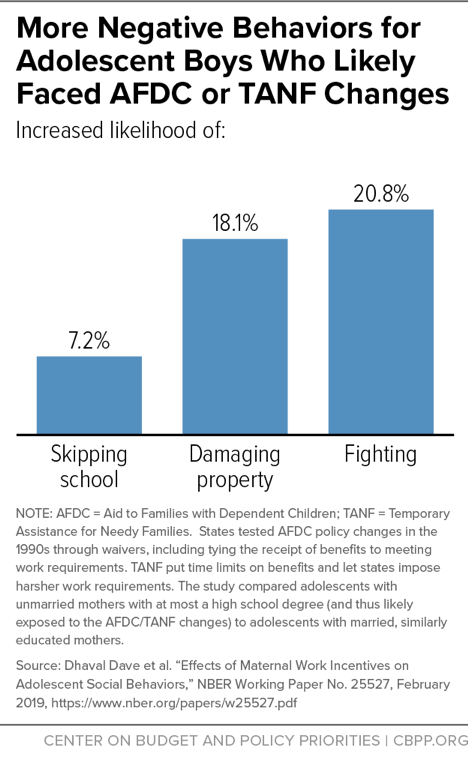BEYOND THE NUMBERS
Restrictions that the federal and state governments imposed in the 1990s on the nation’s main cash assistance program for low-income mothers and their children are associated with negative behaviors in adolescent youth, especially boys, says a study we discussed in our recent research note. The study sheds light on a generally underexplored area of research, with its focus on adolescents, its differentiation by gender, and its consideration of the potential drawbacks of these policy changes. Researchers should conduct more studies to assess the long-term harm that these policy changes may be causing the nation’s adolescents.
Restrictions that state and federal policymakers imposed when the President and Congress ended an entitlement program known as Aid to Families with Dependent Children (AFDC) in 1996 and replaced it with Temporary Assistance for Needy Families (TANF), such as time limits on cash assistance and the loss of an entire family’s assistance if a parent doesn’t meet a work requirement, “have come at a cost to the next generation, particularly to boys,” the researchers concluded. Adolescent boys who were most at risk of exposure to these policies were likelier to skip school, damage property, get into a serious fight, and use marijuana and other substances, the researchers found.
Few quasi-experimental studies have tested how restrictions on direct financial assistance, purportedly designed to boost employment and have other positive effects, have affected adolescent behaviors. Most studies have focused on either parents or younger children, and the few that focused on adolescents examined high school dropout rates and teen fertility rather than a broader array of positive and negative behaviors. Very few studies have examined positive behavioral outcomes of adolescents (or the lack thereof), and few have differentiated the results by gender, according to the study’s researchers.
The researchers assessed adolescents’ participation in positive and negative social behaviors after they were likely exposed to TANF’s policy changes or to similar experimental policies (or “waivers”) under AFDC for at least a year. They compared the behavioral outcomes for 10th- and 12th-grade youth of unmarried single mothers with at most a high school degree — families most at risk of being affected by the policy changes — to their youth counterparts with married mothers who had otherwise similar backgrounds.
The researchers found no evidence that exposure to the policy changes boosted positive behaviors, including volunteering and participation in extracurricular activities, in adolescent boys or girls. While, as noted above, adolescent boys exposed to the policy changes were far likelier to engage in negative social behaviors, including skipping school, damaging school property, and getting in a serious fight in school or at work (see chart), researchers also found increased substance use among exposed adolescent boys and girls.
Adequate family income is important for children’s healthy growth and development, as research from the National Academies of Sciences, Engineering and Medicine shows. Having access to income — such as TANF or food assistance — can help children do better in school, earn more during their careers, and live longer, studies have found. Thus, it’s not surprising that researchers found that exposure to policy changes that create barriers to accessing cash made negative behaviors likelier. In fact, adolescent girls exposed to these policy changes were less likely to volunteer, the researchers found.
Proponents of work requirements and other harsh policies affecting anti-poverty programs often claim that they boost employment and drive other positive outcomes, but the researchers’ findings “do not support culture of poverty arguments that requiring poor mothers to work would make the next generation more responsible.” Rather, the policies may have hindered adolescents’ well-being, health outcomes, and socioeconomic trajectories as they transitioned into adulthood. Given what’s at stake, more research into these underexplored areas is welcome.

